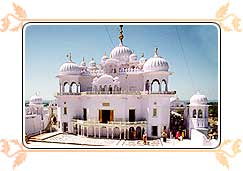Gurudwara Takht Sri Kesgarh Sahib
In 1699, on the occasion of the festival of Baisakhi, Guru Nanak's
mission was fulfilled by the 10th Guru, Sahib Sri Guru Gobind Singh Ji,
when, through baptism of the double-edged-sword the Sikh was
consummated as the Khalsa-Saint Soldier- in direct commune with the
Guru and God. Still more astonishing is the fact that the Guru had got
himself baptised by the Panj-Pyaras, the five beloved ones, who had
offered him their heads to uphold Dharma - the righteous cause.
The Takht Sahib proper is a square hall with a balcony in front
overlooking a spacious courtyard on a lower level. In the middle of
the inner domed room are placed some weapons preserved as sacred
relics. The space being limited on the top of the hill, the sarovar is
on the plain ground west of the Takht Sahib. A large spacious pavilion
is available for larger congregation. Although the town is small, for
the Hola Mohalla every year in the month of March it
bursts alive and recaptures its old glory and splendour.
Sri Keshgarh Sahib
at Anandpur Sahib
|
Unique Attraction of Anandpur Sahib
Hola Mohalla On this annual event, Guru Gobind Singh would organise martial contests between two Khalsa armies, one of attackers (‘Holla’) and other of guardians (‘Mohalla’). The aim of the Holla team was to dislodge the Mohalla team off the hill fort of Lohgarh (Iron Fort) and capture it. The aim of the Mohalla team was to drive back the attackers and keep hold of the fort until sunset. In this military war game, the contestants clashed with each other fiercely, and fought bone-breaking contests with the wooden clubs and sticks. This contest would begin early in the morning and ended at sunset, after which the Guru would reward the victorious Khalsa warriors and those who had shown exceptional daring and skill.
Each year Hola Mohalla marks the congregation of
thousands of
devotees from all over the country for a festival of colour and
gaiety.
|
|
Other Places Of Pilgrimage Importance
Gurdwara Guru-Ka-Mahal (Bhora Sahib) Gurdwara Thara Sahib
Gurdwara Sis-Ganj Sahib Akal Bunga Gurdwara Damdama Sahib Gurdwara Manji Sahib
|
|
Sacred Places Near Sri Anandpur Sahib
Guru-Ka-Lahore Gurdwara Mata Jito Ji Bhai Ghanaiya Ji: His Baoli / Spring |
